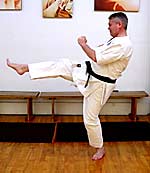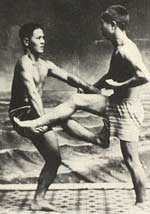The Hips Have It
By Christopher Caile
(With Added Commentary by George Donahue)
 In
karate, taekwondo and kung fu students are constantly reminded about
putting our hips into various techniques to add power. But what is not
said is that sometimes what we don't do with our hips is just as important.
In
karate, taekwondo and kung fu students are constantly reminded about
putting our hips into various techniques to add power. But what is not
said is that sometimes what we don't do with our hips is just as important.
What does this mean? Well, for example, most students are taught that
thrusting your hips into a front kick adds both power and reach. This
is true. But, if you are trying to execute a quick follow up punch,
the forward thrust of the hips actually reduces the speed of your follow
up technique.
That's because when you push your hips forward, you lose your center.
That means you have to pull your hips back to regain your center and
balance before an effective punch can be launched. This takes time and
allows your opponent the opportunity to defend himself more easily.
If instead you hold your hips back when you do a front kick, your follow-up
punch can be launched much more quickly. Here, for example, the punch
begins as the kicking leg is pulled back. The retreating kick and punch
work together, one retreating, the other extending, just as you would
do as if you punched with one arm and then the other. This allows the
possibility of a whole flurry of quick techniques -- punches and kicks.
|  I
have always wondered about the old photo of Chojun Mayagi, the
founder of Goju-ryu, which shows him doing a front kick while
also blocking with both arms. While the particular effectiveness
of the technique shown may be questioned, the photo does illustrate
this same conservation of hip movement so as to be able to execute
simultaneous techniques. I
have always wondered about the old photo of Chojun Mayagi, the
founder of Goju-ryu, which shows him doing a front kick while
also blocking with both arms. While the particular effectiveness
of the technique shown may be questioned, the photo does illustrate
this same conservation of hip movement so as to be able to execute
simultaneous techniques.
|
Another good example of holding the hips back is in the executing of
a front kick that turns into a roundhouse kick. If the hip is extended
into the front kick, it is difficult to follow with a roundhouse kick
with the same leg without pulling the hip back first.
A much more effective method is to hold the hips back when doing the
front kick and then using them to power the following roundhouse kick.
In this way the two kicks can be combined and the second kick launched
much more quickly and powerfully.
On the Other Hand
By George Donahue
Sometimes in martial arts, as in most of our experience, we fall into
the trap of thinking that if something is not "A" then it
must be "B" and only "B." Sometimes there really
are only two choices, but most times there are more choices, if we look
at the situation more intently. We have to be careful that we don't
disregard "C" and even "D" through "Z,"
if they're at hand.
I read my friend Chris Caile's article "The Hips Have It"
with great interest. I agree with Chris completely that the manner of
hanging out the hip to create greater extension and thrust with a kick
is not really optimal, however traditional it may be in certain styles,
particularly those originating in Japan rather than Okinawa. In my younger
days, I used to love it when my sparring partners fell into the error
of overextension-with either the leg or arm-as it usually made for easy
disposal, and it at least greatly improved the odds in my favor, despite
my smaller size. I was also many times able to take advantage of an
attacker's overextension in my days as a nightclub suirakan doorman.
There is no easier way to take someone's balance than by letting him
do the work for you himself.
However, to keep the hips retracted and/or centered sacrifices too much
potential power, limits the kicking range and height, and severely constrains
delivery speed. It allows your attacker to stay much closer to you and
to dictate ma-ai, the fighting distance. You cannot maximize your effort
if you stay in a state of contraction, hips at neutral.
So, in this case, neither "A," extending into the kick, or
"B" not extending into the kick, is without limitation. Both
have some pluses, but both have some heavy negatives, too. That means
it's time to start thinking about whether there might be other alternatives.
In fact, there are more than one that I'm aware of, and there are probably
many more that I haven't seen or figured out yet, but we'll keep matters
simple by discussing only one, the most basic, which incorporates elements
of both "A" and "B."
Okay, here is yet another way to kick, one that involves driving with
the hips, extending with the hips, and snapping back with the hips.
We won't call it "C," because then you might have broken the
habit of thinking there are only two ways to kick and simply fall into
the habit of thinking there are just three ways to kick. We'll call
it "G," so that it will prompt you to think about what "C"
through "F" might be, and whether there might also be alternatives
"H" through "?".
In any stance conducive to kicking, with your hips neutral, begin by
driving the hip in your non-kicking leg forward, without letting either
of your feet go anywhere. When you've stretched your stance as far as
it will stretch without snapping or toppling, then with all the power
you can muster thrust the hip of your kicking leg toward your target,
without letting your kicking foot go anywhere. When you've reached the
state of maximum stretch of your kicking leg, release your kicking foot.
Allow the stretch of your stance and your kicking leg to snap your foot
to the target, like a big rock on the end of a giant rubber band. Your
hip will be in the lead and will be in a position similar to that used
in ordinary thrust kicks. However, you will not extend fully until after
contact, saving the last six inches or so of your now increased reach
to drive through the target. Here's where you get into trouble if you
don't have good mastery of your koshi, not just the hips but the entire
pelvic carriage and the muscle and connective tissue surrounding it.
As you drive through your target, your driving hip is already changing
direction and heading back to neutral. It's working like the handle
of a very thick whip to snap your foot (or knee) through the target
and then continue to snap it back through the target so that, in essence,
you're kicking on the way in and on the way out.
Method "G" won't work if you keep your hips on a single horizontal
plane. You have to swivel them like a sexy walker to execute this technique
successfully. Loosen up; give it a try.
About The Authors:
Christopher Caile is the Founder and Editor-In-Chief of FightingArts.com.
He has been a student of the martial arts for over 40 years and holds
a 6th degree black belt in Seido Karate and has experience in judo,
aikido, diato-ryu, boxing and several Chinese fighting arts. He is
also a long-term student of one branch of Traditional Chinese Medicine,
Qigong. He is a personal disciple of the qi gong master and teacher
of acupuncture Dr. Zaiwan Shen (M.D., Ph.D.) and is Vice-President
of the DS International Chi Medicine Association. In Buffalo, NY,
he founded the Qi gong Healing Institute and The Qi Medicine Association
at the State University of New York at Buffalo. He has also written
on Qi gong and other health topics in a national magazine, the Holistic
Health Journal and had been filmed for a prospective PBS presentation
on Alternative Medicine. Recently he contributed a chapter on the
subject to an award winning book on alternative medicine, "Resources
Guide To Alternative Health" produced by Health Inform.
George Donahue is a senior acquisitions editor at The Lyons
Press, in Guilford, Connecticut, where he edits business, sports,
military history, outdoors, and fiction books and is currently establishing
a martial arts publishing program. Prior to a brief retirement to
write books in Vermont, he had been the executive editor of Tuttle
Publishing in Boston and before that an editor for many years at Vintage
Books in New York City. A 6th dan Shorin Ryu Karatedo student of Shinzato
Katsuhiko and the late Kishaba Chokei and Nakamura Seigi, he is the
director of Kishaba Juku of New York City and an inveterate karate
and kobujutsu seminar instructor. He is also a member of FightingArts.com's
Advisory Board and a contributor to the website.